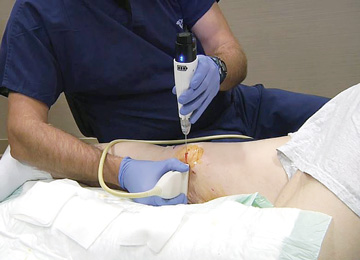Cryoanalgesia is emerging as a compelling option for managing the immense pain of total knee replacements. Its specific application for total knee pain management is gaining interest and proponents in the orthopedic community like Joshua A. Urban, MD. Since 2018, Dr. Urban, an orthopedic surgeon who performs total hip and knee replacements with OrthoNebraska in Omaha, and his physician assistant have performed almost 1,200 cryo procedures.
He performs the treatment two to three weeks before knee replacement surgery, and it essentially mutes the nerves that send pain signals to the brain, while sparing the nerves that regulate motor function. The block lasts up to four months — including the majority of the typically excruciating pain period post-surgery.
“Total knees have a well-earned reputation of being barbarically painful,” says Dr. Urban. Postoperatively, an immediate concern for patients is ensuring that the knee doesn’t stiffen and muscles don’t atrophy. “As soon as patients wake up, we tell them to start moving their knee, and it’s akin to doing a big hernia surgery and having them do crunches right away,” he says.
Surgeons have traditionally prescribed opioids to help their patients cope with the immense pain. But as the industry continues to phase out opioids whenever possible, the idea of an extremely long-term block that removes pain but doesn’t affect the patient’s ability to ambulate is appealing to surgeons and patients alike.
“A nerve block is the best way to control pain because you just shut the message down,” says Dr. Urban. Although perioperative blocks placed by anesthesia work well, they are short-lived. “If you use liposomal bupivacaine, it’s two or three days tops, and then the pain comes,” he says.
By freezing the knee’s sensory nerves at minus-88 degrees Celsius, cryoanalgesia essentially kills them, and they then grow back over time. “If you’re blocking the patient’s nerve mid-thigh, and it has to regenerate down the whole thigh back to the knee, you’re buying the patient three to four months of that nerve being shut off,” says Dr. Urban, who also employs Enhanced Recovery After Surgery (ERAS) and multimodal techniques to manage his total knee patients.
Getting patients to accept the treatment isn’t an issue, says Dr. Urban, but explaining it to them is vital. Dr. Urban avoids using technical terms and explains the process in an easy-to-understand manner: “We’re going to stick a probe under ultrasound to the nerve and freeze it without putting you under. We’re going to do this by making little holes, but we anesthetize you so you don’t feel it. You’re going to have numbness at the top of your knee for about three to four months — and no pain.”
.svg?sfvrsn=be606e78_3)

.svg?sfvrsn=56b2f850_5)